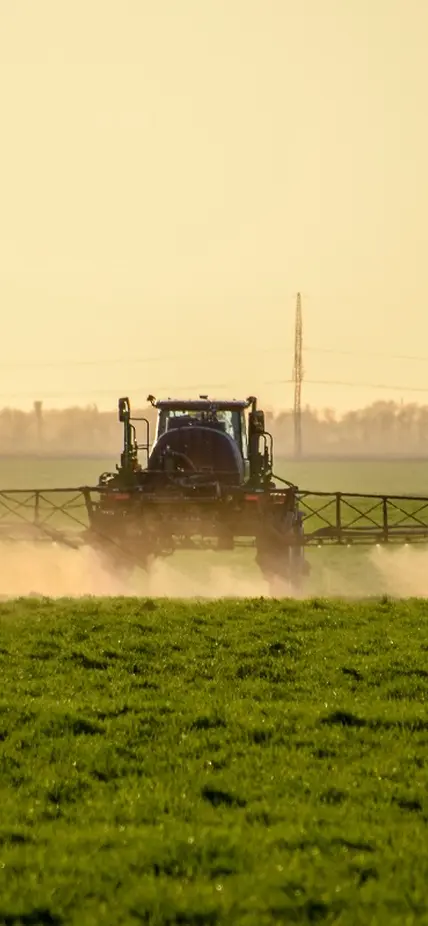Washington, D.C.— The majority of nitrogen-based fertilizer could be supplied by renewable-energy-driven, small-scale technologies by the end of the decade if production is decentralized according to a new study in Nature Food led by Carnegie Science’s Lorenzo Rosa and Davide Tonelli. Shifting to farm-scale production of sustainably synthesized green fertilizer could increase food security, particularly in Sub-Saharan Africa, they found.
Nitrogen fertilizers are made by turning atmospheric nitrogen and fossil-fuel-derived hydrogen into ammonia using an energy-intensive technique that was developed in the early 20th century called the Haber Bosch process. Right now, nitrogen fertilizers that are synthesized in this manner are used to grow food that feeds 3.8 billion people, or half of the global population.
“Nitrogen fertilizers are the largest contributor to both costs and greenhouse gas emissions in cropland agriculture. It's clear that transformative measures are required to achieve the goal of net-zero carbon emissions by 2050, while simultaneously reducing costs,” Rosa indicated.
The Haber Bosch process is energy intensive—requiring natural gas or coal—and releases about 1 percent of global greenhouse gas emissions every year—a number that is expected to increase dramatically by 2050 due to population growth and changing diets.
Additionally, the production of nitrogen fertilizers is highly centralized, taking place in about 500 large-scale manufacturing facilities around the world. And the fossil fuels used during the synthesis process are often imported to the manufacturing site, too.
“Both of these factors make fertilizers production—and the entire global food supply—vulnerable to supply chain disruptions such as geopolitical conflicts and extreme weather events,” Tonelli explained. “Additionally, long-distance transportation and tariffs incurred between the production facility and the demand point can significantly increase the final fertilizers price.”
Tonelli and Rosa explored on-farm production options for synthesizing green fertilizer without using fossil fuels: the electric Haber Bosch process and electrocatalysis. Both can make fertilizers from electricity, which can be supplied from on-site agrivoltaic solar panels directly installed on croplands. The former requires an electricity or intermediate hydrogen storage capacity to mitigate the impact of intermittent renewables production, while the latter could follow the production load of solar panels.
Rosa, Tonelli, and their coauthors—Paolo Gabrielli of Carnegie Science and ETH Zurich, Alessandro Parente of Université Libre de Bruxelles, and Francesco Contino of UCLouvain—evaluated the cost competitiveness of these green fertilizer production methods as compared to the current centralized production with the Haber Bosch process.
“We found that by accounting for transportation costs and supply chain disruptions, up to 96 percent of ammonia-based fertilizer could be competitively produced at farm scale by 2030,” Tonelli said.
Sub-Saharan Africa and North America are particularly well positioned for success in competitively priced green fertilizer production, whereas Northern Europe and inland China will face the greatest challenges.
“Removing reliance on fossil fuel and fertilizers transportation challenges could increase food security for farmers in regions that are distant from industrial centers and infrastructure,” Rosa said.
He added: “We set out to determine whether small, decentralized fertilizers production technologies hold the key to overcoming the challenges posed by conventional large-scale Haber-Bosch facilities. Our findings show that adopting a distributed approach can revolutionize ammonia production, paving the way for a sustainable, resilient, and low-carbon agriculture.”
This work is a key component in Rosa’s ongoing research about challenges and opportunities in ensuring global food, water, and energy security. Ecologists at Carnegie are focused on informing the sustainability of the Earth system, including exploring how we can provide sustainable access to energy, food, and water, and how we can deploy climate mitigation strategies with minimal unintended consequences.
Rosa joined Carnegie in 2022 as a Staff Associate—a prestigious program designed to give early career scientists the freedom and independence to pursue bold and unconventional research. Since then, his efforts have included analyses of irrigation strategies, soil moisture-retention techniques, and water storage needs, as well as evaluating solutions to reduce the carbon footprint of fertilizer production and achieve net-zero emissions in agriculture.
